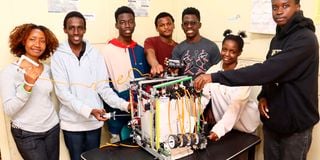Students create robot to help tackle climate crisis

Team Kenya Robotics with a robot they have built at Kivuli Center, Nairobi on September 15, 2023.
What you need to know:
- In the long term, the innovators say they aim to refine and exploit technology to capture significant amounts of carbon, making a substantial contribution to combating climate change.
- Several studies estimate the cost of mitigation and adaptation and compensation for loss and damage to be about $580 billion in 2030 and could be as high as $1.8 trillion by 2050.
Studious silence welcomes you to a makeshift laboratory at Zetech University main campus in Ruiru, Kiambu County.

A robot built to fight negative impacts of climate change at Kivuli Center, Nairobi on September 15, 2023.
A group of 10 young university students are immersed in their work as they fix one piece after another; with a whiteboard populated with scientific scribbles forming the background.
Driven by necessity and passionate about technology, the Kenyan innovators have built a robot that they believe can help overcome one of the biggest challenges facing the planet today — the climate crisis — through robotic games.
The effects of climate change have become increasingly evident across the globe, with Kenya just coming out of her worst drought in 40 years following more than four consecutive failed rainy seasons due in part to the adverse effects of climate change.
The consequences of the drought have been severe if not devastating; with poor populations in arid and semi-arid areas bearing the worst brunt having lost more than 2.5 million head of livestock, according to the State Department of Livestock.
However, rapid advances in artificial intelligence (AI), green information and communication technologies and robotics offer some hope in the fight against climate change.
Robotics, combined with artificial intelligence-driven applications,are helping governments, manufacturers and key stakeholders to manage and reduce carbon footprint.
With Kenya’s economy largely dependent on tourism and rain-fed agriculture, both susceptible to climate change and extreme weather events; the university students are now betting on their innovation to be a key weapon in the fight against climate change. Touted as a potential tech tool in cutting global carbon emissions and building resilience to climate change, the students see their innovation as a pathway to meeting long-term emission targets of net-zero emissions by 2050. The innovators represented Kenya in the First Global Robotics International Challenge in Geneva, Switzerland where they won a Silver Medal in October last year. Florida Korir, the group’s team leader, explains that the robot’s primary function is to collect balls that symbolise carbon in the atmosphere and thereafter safely store them, representing carbon capture.
She avers that the robot operates autonomously guided by a combination of sensors and programming. “The robot is designed to navigate and collect carbon-representing balls and then securely store them,’’ she explains.
Florida says the idea was conceived to address climate change challenges; with the students focusing on carbon capture through robotics.
She explains that the innovation aims to contribute to climate change mitigation by capturing and storing carbon, thus reducing the concentration of greenhouse gases in the atmosphere. Though not yet commercialised or patented, the innovators are looking at replicating and expanding the technology. “We are looking at scaling up this innovation and creating more robots capable of capturing carbon in larger quantities, making a meaningful impact on reducing global warming,’’ notes Florida.
In the long term, the innovators say they aim to refine and exploit technology to capture significant amounts of carbon, making a substantial contribution to combating climate change.
Several studies estimate the cost of mitigation and adaptation and compensation for loss and damage to be about $580 billion in 2030 and could be as high as $1.8 trillion by 2050.
The group says some of the challenges they are currently facing are resource constraints and limited access to advanced technology.
“Addressing these challenges would require financial support, mentorship and collaboration with industry experts,’’ they say.
Zetech University notes that the robot innovation by its students has inspired other innovations at the institution such as the eco-mobilus innovation that involves converting commercial gasoline motorcycles into electric powered bikes.
This involves replacement of gasoline kit including the engine, the fuel tank, pedal accelerators and dash board, alternators, among other related components with an electric kit and locally manufactured high performance 3KwhLithium battery to yield a maximum of 100km per single charge with load weight of 150 kilogrammes.
The Eco-Mobilus innovation is spearheaded by Paul Waweru and Prof Gitau Kamau and is aimed at reducing massive pollution caused by vehicles powered by fossil fuels.
The transport sector accounts for a quarter of global fuel-related greenhouse gas emissions, with half coming from private vehicles, including passenger cars and trucks.
“The robotic games innovation that went ahead to be showcased in the inaugural Global Robotics International Challenge in Geneva, where they won a Silver Medal last year, has really inspired other innovators to exploit technology to solve modern problems that can be fixed using technology,” the university said in a statement.
According to Dr Kinyanjui Koimbori, a climate and resilience researcher, robotic technology is used in other parts of the world like Saudi Arabia in mitigating impacts of climate change.
He explains that drones have become new tools in the fight to preserve the environment.“In the desert country, cloud seeding, which uses drone technology, is used to harness rain. The technique, despite being expensive, helps clouds to produce rain in an artificial way,” avers Dr Koimbori.
He adds that India uses machines that can capture carbon dioxide.
“The scientific process is called carbon sequestration and it can be done naturally using trees, oceans and mangroves, which absorb the carbon dioxide released in the air.”





